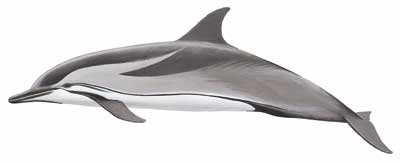Stenella coeruleoalba
Form and Function
The body of the Striped Dolphin has many
adaptations, all designed to make life in the ocean as efficient as
possible. They have a long, sleek, streamlined body that is designed for fast movement in the water(Reeves 2002). The top of their
bodies is a darker shade of gray while their ventral surface is a
lighter shade. This differing in coloration allows the dolphins to blend
in to their surroundings (Ridgway 1972). This means that a predator
attacking from above would have difficulty finding the dolphin because
it’s dorsal surface camouflages it against the dark ocean bottom. On the
other hand, a predator attacking from below would have difficulty
finding the dolphin, because its light belly camouflages it against the
sky. However, the most distinguishing and easily recognizable feature of
the Striped Dolphin is the charcoal grey stripe that runs the entire
length of the body; from beak to tail (Ridgway 1972). As stated by the
National Oceanic and Atmospheric Administration, the colors of the young dolphins, or
calves, tend to be less prominent than those seen in the adult Striped
Dolphins.
The Striped Dolphin also has three different types of fins,
all which serve a different purpose. The dorsal fin is located on the
dolphin’s back. The shape and location of this fin allows it to act as a
balance- it keeps the dolphin upright and prevents it from rolling
unintentionally (Lily 1961). The dorsal fin is different in every single
dolphin, making it equivalent to a human fingerprint. Dolphins in
captivity are often recognized by their dorsal fin (Lily 1961). The
Striped Dolphin also has a pair of flippers, located on either side of
its ventral surface that aid in steering the dolphin. The dolphin’s tail
is it’s third fin, and since it is very muscular, it propels the dolphin
through the water (Ridgway 1972).
The eyes of the Striped Dolphin also contain
special muscles that allow dolphins eyes to focus above and below water
(Lily 1961). This allows them to judge distances and movement happening
above the water much more efficiently.
Another distinguishing feature of the Striped Dolphin is the
blowhole. This hole, located on the dorsal surface of its body, is used
to obtain oxygen when the dolphin surfaces above the water. It is an
external opening to the lungs, like a nose in humans (Ridgway 1972).
Dolphins also have a unique feature, located in their
forehead, called the melon. As stated by Public Broadcasting Service,
the melon is the main organ responsible for the process of echolocation.
In order to locate prey, or detect objects in the distance, a dolphin
sends out sound waves in a series of clicks through the water. These
waves travel until they encounter an object. They are then bounced off
the object and travel back to the dolphin. The time is takes the waves
to return tells the dolphin how far away the object is (PBS). This makes
it much easier to find prey, predators, or other dolphins in the water.
To continue to learn about this fascinating species visit the Nutrition page or go back to the Home page